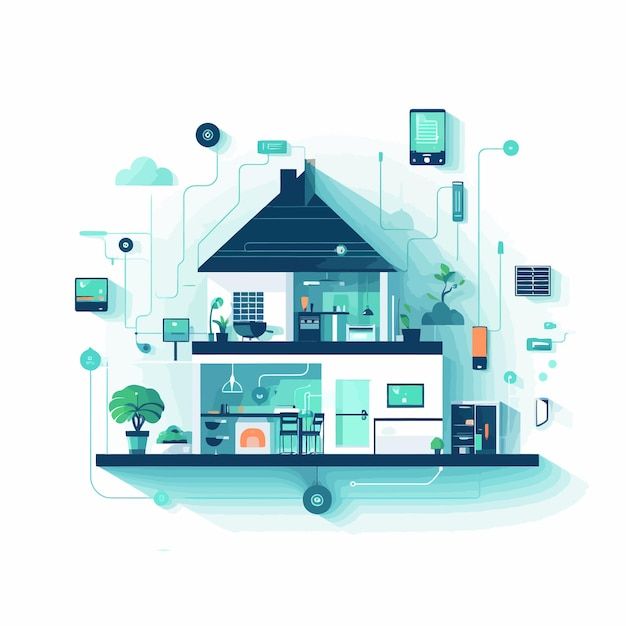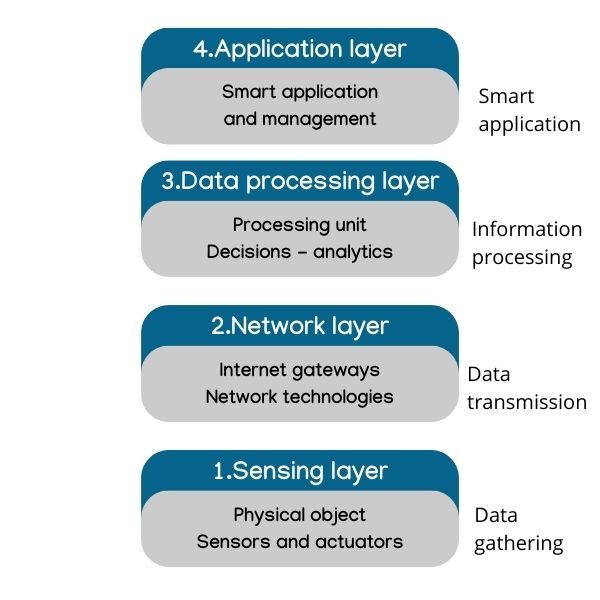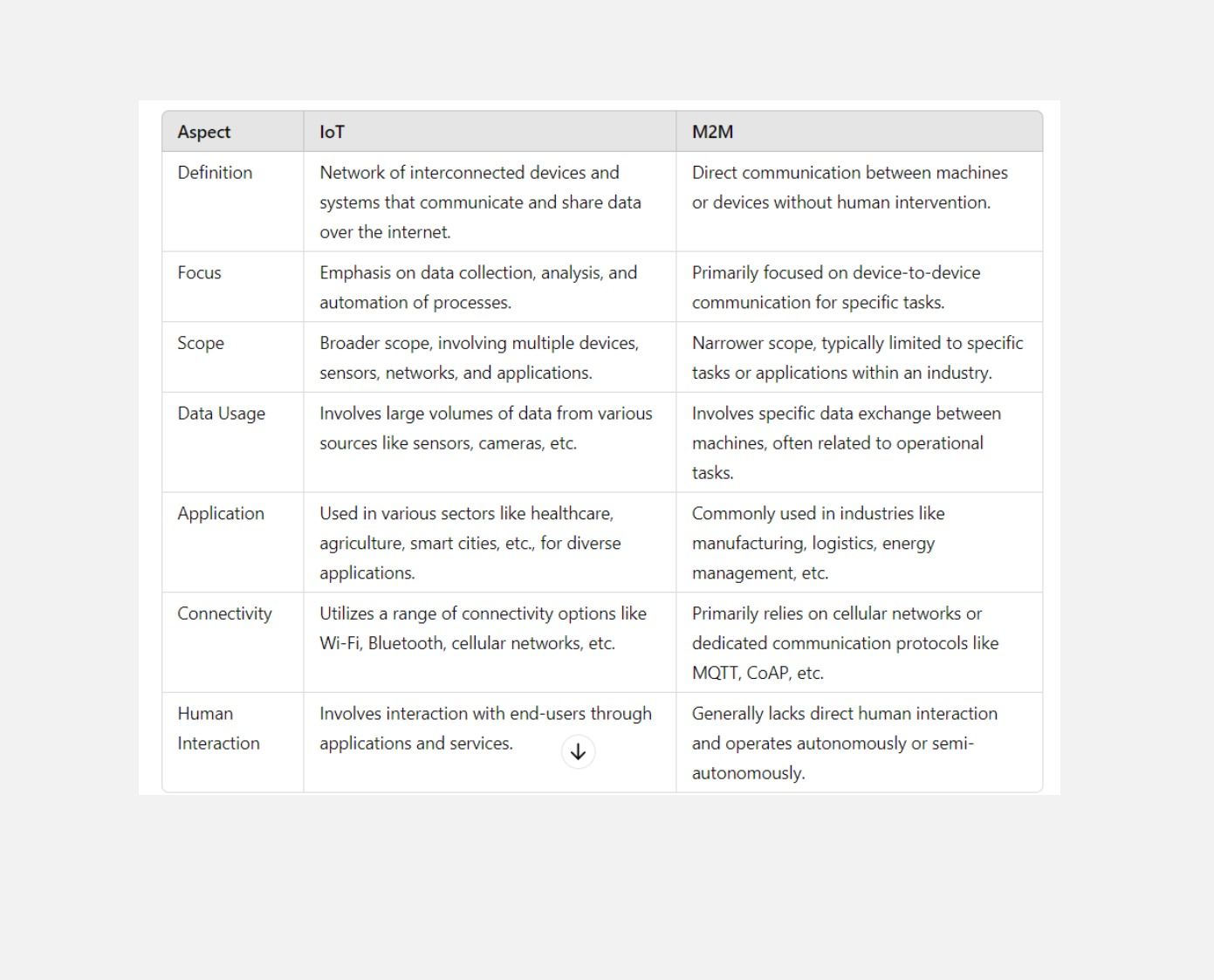
IoT Architectural view, IoT Sources and M2M Communication
What is Internet of Things (IoT)?
- IoT refers to a network of interconnected devices and objects that can collect, exchange, and analyze data without human intervention.
- These devices are equipped with communication technologies like Wi-Fi, Bluetooth, or cellular networks to connect to the internet.
- Appliance of devices that we used in our daily lives and when we connect theses devices to the internet it is called IOT .
Vision of Internet of Things (IoT)
IOT vision is to design and develop an online interacting platform where physical object will interact with object or persons remotely.
Internet Oriented Vision
- device contribute and collaborates with each other over the internet .
- Sensors keep on tracking the devices with unique identification number assigned to it.
Things Oriented Vision
- There is the focus on each individuals device.
- This each devices in IOT network is viewed as a discute entity with its own set of characters such as sensors of processing and connecting options.
- These devices are designed to operate automatically , collecting and transmitting the data to others device,
- This recognize the importance of each individual of device in the network and emphasize the need of interoperability and scalability.
Semantic Oriented Vision
- The amount of information gathered by the sensor in enormous. As the result the information gathered is processed efficiently.
- Raw materials are processed to consolidate and reduce recycling. This improves understanding.
- IOT's massive data problem would be solved by emergence of semantic technologies.
Conceptual Framework of Internet of Things (IoT)
There are several device that collects data from dispereplace and relay that information to CPU for the data management , acquisition and analysis.
we can conceptualise IOT with single equation. physical object + sensor/actuators + internet = IOT
- Oracle give equation that tells how to define IOT
Gather + enrich + stream + manage + acquire + organise and analyse
- Level-1 Gather :- information is gathered via device through via sensor and internet.
- Level 2 Enrich :- Gathered information is improved by process like transcoding ( encoding and decoding ) and act as a gateway between 2 devices .
- Level 3 Stream :- It includes the transmission and reception of data stream managed by communication subsistent.
- Level 4 Managed :- At this point the device data is received by device management and access management subsistent.
- Level 5 Acquare :- The information collected is stored in the data repository .
- Level 6 organise and analyse :- It is responsible for organising and analysis the data set by the object.
Layers of IoT Architecture
- Application Layer
- Data Preprocessing Layer
- Network Layer
- Sensing Layer

Sensing Layer
- Sensor equip smart layer ( smart objects) make up the information of foundation layer.
- The sensor fetches the data to be gathered analyse it in realtime.
- Different types of sensor may serve distinct functionalities .
- for eg . temperature , air quality speed , humidity and so on . May all be measured through sensor. some of the may include memory .
- A physical attribute may be measured by a sensor which transmit a signal that can be interpreted by an instrument.
Network Layer
- It is also known as gateway layer the massive amount of generated of data
- generated by these small sensor need a reliable high performance on wired and wireless architecture.
- The machine to machine network and application that rely on them have
- been supported by existing network even though these networks are bounded by completely different protocolos.
- Private , public or hybrid network exist to tailor the certain needs in terms
- of latency capacity or security in the data transmission different gateway and gateway network .
Data Preprocessing Layer
- It is also known as management service layer . The data is transmitted through the gateway is stored and processed security .
- With loud sever i.e data center from where the data is accessed by the software application turned as business application .
- The processed data is used to perform intelligent activates that make our devices smart.
Application Layer
- End user app or mobile app help and user to monitor or control their devices from remote location.
- These application take important info from the cloud and display on your smartphone.
- The main task where the visualisation and management of important information with
- help of these application user send commands to server to perform some actions like change default temperature of air condition.
- IoT devices use standard internet protocols like TCP/IP, HTTP, or MQTT for communication and data exchange over IP networks.
Technology Behind IOT
Sensors and Actuators
- Sensors collect data from the environment, such as temperature, humidity, motion, or light.
- Actuators perform actions based on the data received from sensors or user commands.
Connectivity
- Wireless protocols like Wi-Fi, Bluetooth, Zigbee, and cellular networks
- (4G/5G) enable devices to connect and communicate with each other and the internet.
- Wired connections, such as Ethernet, are also used in some IoT applications.
Communication Protocols
- Lightweight communication protocols like MQTT (Message Queuing Telemetry Transport) and
- CoAP (Constrained Application Protocol) are used for efficient data transfer between devices.
- These protocols are designed to work well with limited bandwidth and power-constrained devices.
Edge Computing
- Edge computing brings data processing closer to the source (IoT devices) to reduce latency and improve real-time decision-making.
- It allows for local data analysis and filtering before sending relevant information to the cloud.
Cloud Platforms
- Cloud platforms, such as Amazon Web Services (AWS), Microsoft Azure, and Google Cloud,
- provide scalable infrastructure for storing, processing, and analyzing IoT data.
- They offer IoT-specific services for device management, data ingestion, and analytics.
Integration and Interoperability
- Middleware platforms and APIs facilitate integration between diverse IoT devices, protocols, and applications,
- ensuring interoperability and seamless data exchange.
- Example: An IoT middleware platform translates data from different sensors into a common format for analytics and decision-making.
Sources of IoT
The Internet of Things (IoT) relies on various sources and technologies to enable connectivity, data exchange, and automation.
Wi-Fi
- Wi-Fi technology allows IoT devices to connect to local area networks (LANs) and the internet wirelessly,
- providing high-speed data transmission and connectivity within a certain range.
- Example: Smart home devices like cameras, and speakers connect to Wi-Fi networks for remote control and data sharing.
Bluetooth
- Bluetooth technology enables short-range wireless communication between IoT devices, s
- martphones, and accessories,facilitating seamless data transfer and device pairing.
- Example: Wearable fitness trackers use Bluetooth to sync data with mobile apps for activity tracking and analysis.
Zigbee and Z-Wave
- These low-power wireless protocols are commonly used in smart home automation for creating mesh networks,
- allowing devices to communicate efficiently with minimal energy consumption.
- Example: Smart lighting systems use Zigbee or Z-Wave to control and coordinate multiple light bulbs in a home network.
Cellular Networks
3G/4G/5G
- Cellular networks provide IoT devices with wide-area connectivity,
- allowing them to transmit data over long distances using cellular infrastructure and SIM cards.
- Example: GPS trackers for vehicles use cellular networks to send real-time location data to fleet management systems.
Satellite Communication
- In remote or rural areas with limited terrestrial connectivity, satellite internet services enable IoT devices to access the internet and communicate globally.
- Example: Environmental monitoring systems in remote regions use satellite communication to transmit weather data and alerts.
Machine-to-Machine (M2M) Communication
- M2M means no human intervention .
- It is a direct communication system between device using wired and wireless communication without human intervention.
- It collects and share it with other machine .
- for eg Controlling air condition with a smartphone using bluetooth we are in home so on internet is required thi is M2M when we control from a far distance over internet is called IOT .
How M2M Communication Works
Direct Device Interaction
- M2M communication involves direct communication between IoT devices, sensors, or machines without human intervention.
- These devices are equipped with sensors and communication modules to send and receive data.
Data Exchange Protocols
- M2M communication relies on standardized protocols such as MQTT (Message Queuing Telemetry Transport), CoAP (Constrained Application Protocol),
- and AMQP (Advanced Message Queuing Protocol) to ensure efficient and reliable data transmission.
Real-Time Monitoring and Control
- M2M communication allows devices to monitor real-time data such as temperature, pressure, or location,
- and take automated actions or provide feedback based on predefined rules or algorithms.
Scalable and Distributed Architecture
- M2M communication frameworks are designed for scalability and flexibility, allowing thousands or
- even millions of devices to communicate seamlessly in distributed environments such as industrial facilities or agricultural fields.
Secure Data Exchange
- Security protocols and encryption mechanisms are implemented in M2M
- communication to protect data integrity,and authenticity during transmission, ensuring secure interactions between devices.
Difference Between IOT and M2M

Conclusion
We have explored Internet of Things (IoT): Conceptual framework, Architectural view, Technology behind IoT, Sources of the IoT, M2M Communication, IoT examples.